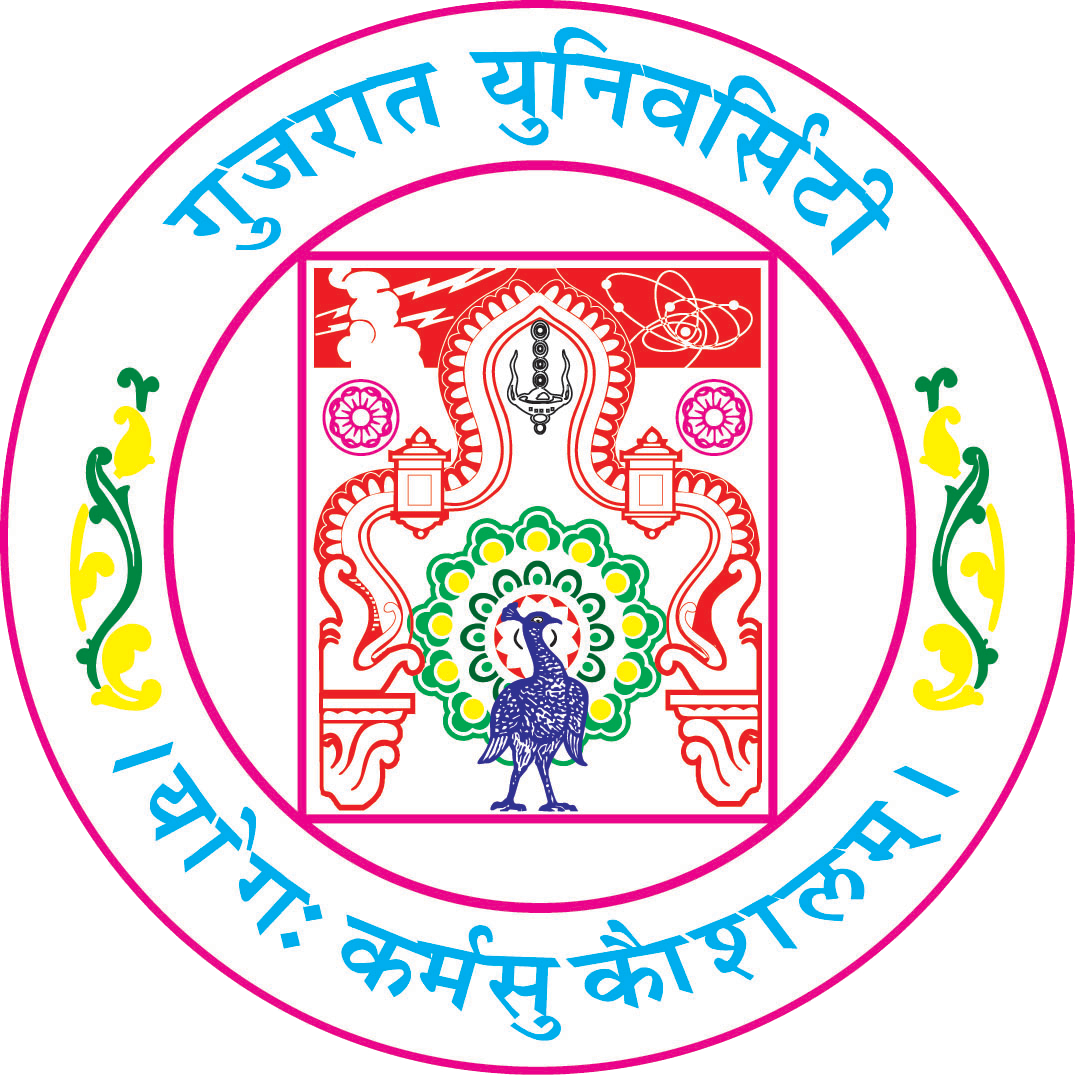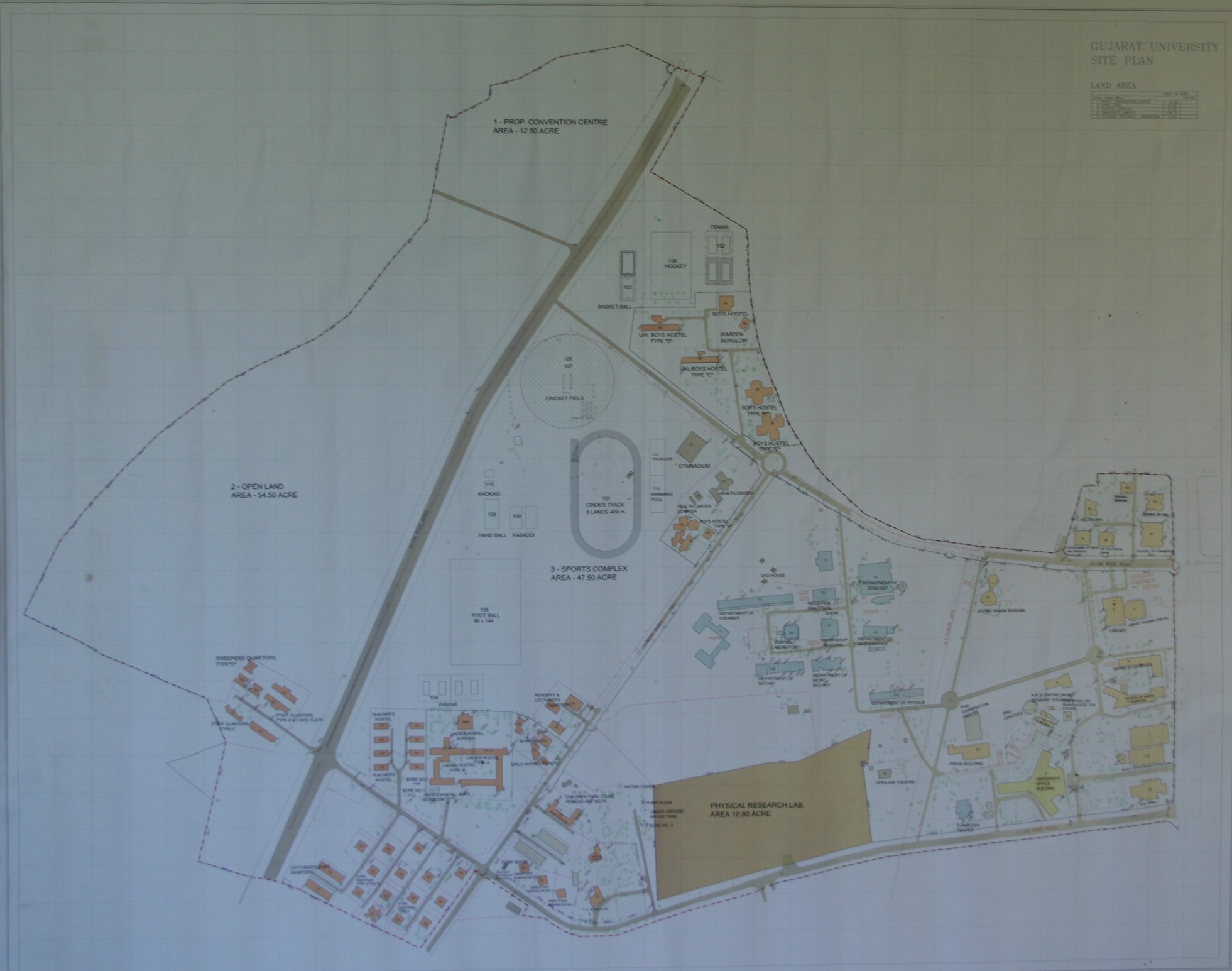 |

|
|

|
|
|
Gujarat Navrangpura, Ahmedabad – 380
009, Phone : +91-079-26301341, +91-079-26300342/43
Fax : +91-079-26302654 Website :
www.gujaratuniversity.org.in (Established 23rd November, 1949) Chancellor...................... : Hon. The Governor of Gujarat, Shri Om Prakash Kohli Vice-Chancellor............. : Dr. Himanshu A. Pandya
Pro-Vice-Chancellor...... : Vacant Registrar........................ : Dr. P. M. Patel (I/c)
An Overview
|
||||||||||||
|
Brief
History Established in 1949 under the Gujarat University Act, the Gujarat University is largest and oldest university of the Gujarat state. The idea of setting up the university conceived in 1940s and the seed of inceptions was laid down by Shri Sardar Vallabhbhai Patel under the chairmanship of Mr. G. B. Mavlankar in consultation with Mr. Kasaturbhai Lalbhai and Acharya Anand Shankar Dhruv. Gujarat University is affiliating university, having more than 350 affiliated colleges, 35 post graduate departments and more than 50 affiliated post graduate centres with diversified courses in faculties of 1. Arts, 2. Commerce 3. Science 4. Education 5. Law 6. Medical and 7. Dental. The university spans over eight districts like Ahmedabad, Gandhinagar, Kheda, Anand, Vadodara, Panchamahal, Dahod, Mahisagar and two union territories. Therefore, it covers a significant geographical area of the state and provides expressions to the educational aspiration of about 2 Crore Urban, Rural and Tribal communities of the region. Starting with the only university in the region during the erstwhile Bombay Province, at present almost all 10 universities of the state have evolved from Gujarat University.
|
||||||||||||
|
Gujarat
The emblem of the
The motto
|
||||||||||||

Organisation &
Management The The court
(Senate) is the chief authority of the University. Subject to the provisions of
the Act, the court makes statutes setting forth in details the broad provisions
of the Act, e.g., the composition of the statutory bodies, definition of their
powers, mode of election etc.
The Executive
Council is the executive authority of the University and deals with matters such
as prescribing conditions governing the various activities of the University.
The Academic
Council is in-charge of the academic affairs of the University and is
responsible for the maintenance and standards of instructions, education and
examinations subject to the provisions of the Act and statutes made under the
Act. The authorities
of the University are: (1) The Court
The University
officers are:
The Vice-Chancellor heads the University. The working of the University is purely democratic as all the faculties as well as students are duly represented. Moreover, elections to the Senate are held every year. The principals of the colleges look after the college administration. Teachers of the colleges, departments and schools do not form a formal administrative structure but they are represented in the power bodies of the Universities such as Academic and Executive Council. The Registrar is the administrating head of the university. All the officers report to him. The details regarding the sections of the University administration are given in Appendix -20. The teaching, non-teaching staff £ have the right to represent their grievances and complaints through their unions. There are unions for teaching and non-teaching staff. There are four unions representing non-teaching staff of the university. The University also recognizes the association of Principal’s and non-teaching staff of affiliated colleges. Thus the University plays the role of a regulator and acts as a bridge among the stakeholders of education.
|
||||||||||||
|
Objectives
of the University 1) To provide instruction including
correspondence courses, teaching and training in such branches of learning and courses of study as it may think fit, to make
provision for research, advancement, and dissemination of knowledge, and to
conduct special undergraduate courses for talented students; 2) To make such provision as would enable affiliated colleges, recognized
institutions and approved institution to undertake specialization of
studies; 3) To establish, maintain, take over by agreement and manage colleges,
departments, centers and institutes of research or specialized
studies; 4) To organize common laboratories, libraries, museums and other equipment
for teaching and research; 5) To establish within the University area or outside that area such field
stations, specialized laboratories and other units for research and instructions
as are necessary for the furtherance of its objects; 6)
To
create such teaching, administrative and such other posts as the University may
deem necessary from time to time and to make appointments
thereto; 7)
To
institute professorships, readerships, lectureships and other posts of teachers
required by the University; 8)
To
appoint or recognize persons as professors, readers, or lecturers, or otherwise
as teachers of the University; 9)
To
guide teaching and research work in colleges, University Departments, University
centers and recognized institutions; 10)
To
lay down the course of instruction for the various
examinations; 11)
To
institute degrees, diplomas and other academic titles and
distinctions; 12)
To
hold examinations or tests and confer degrees and diplomas on, and gant
certificates to, persons who- a)
have
purchased approved courses of study in the University ore in an affiliated
college, unless exempted there from, in the manner prescribed by the Statutes.
Ordinances, Regulations and Rules and have passed the examinations or tests
prescribed by the University, or b)
have
carried on research under conditions prescribed by the States, Ordinances,
Regulations or Rules; 13)
To
confer honorary degrees or other academic distinctions in the manner laid down
by Statutes; 14)
To
grant such diplomas to, and to provide such lectures, instruction and training
to, persons who are not enrolled students of the University, as may be
determined by the Statues, Ordinances, Regulations and Rules; 15)
To
withdraw or cancel any degree, diploma or certificate conferred or granted by
University in the manner prescribed by Statues; 16)
To
associate or admit educational institutions with or to the privileges of the
University by way of affiliation, recognition or approval; 17)
To
withdraw or modify either in whole or in part, affiliation, recognition or
approval of educational institutions; 18)
To submit to the State Government proposals for conferment of autonomy on any affiliated
colleges or a University college, or a University Department or a recognized
institution entitling it to privileges in the in the matters of admission of
students, prescribing the courses of study, imparting instruction, teaching and
training in the courses of study, the holding and conduct of examinations and
the powers to make necessary rules for the purpose; 19)
To recommend to the State Government withdrawal of
autonomy conferred on any affiliated college, recognized institution or a 20)
To
inspect colleges, recognized institutions and approved institutions and to take
measures to ensure that proper standards of instruction, teaching and training
are maintained in them and that adequate library and laboratory provisions are
made therein; 21)
To
lay down and regulate the salary scales, allowances and other conditions of
service of the members of the teaching, other academic and non-teaching staff of
the University; 22)
To
lay down and regulate the salary scales, allowance and other conditions of
service of the members of the teaching, other academic and non-teaching staff in
the affiliated colleges, and recognized and approved
institutions; 23)
To
provide for the establishment and recognition of Students' Unions or
associations of teachers, academic staff or other employees of the University,
affiliated colleges and recognized institutions; 24)
(a) To control and co-ordinate the activities of, and
give financial aid to affiliated colleges and recognized and approved institutions; and (b) To regulate the fees to be paid b y the students in
affiliated colleges, and recognized and approved institutions 25)
To
hold and manage trusts and endowments; 26)
To
Institute and award fellowships, traveling fellowships, scholarships,
studentships, medals, prizes and other wards; 27)
To
make special provision for the spread of University education among classes and
communities which are educationally backward; 28)
To
lay down courses of study to meet the requirements of rural planning,
development and reconstruction and to provide for instruction, teaching and
training in such courses; 29)
To
make special provision for disseminating knowledge and promoting arts and
culture; 30)
To fix, to demand and to receive or recover such fees
and other charges as may be prescribed by
Ordinances; 31)
To
establish, maintain and manage hostels; 32)
To
recognize hostels not maintained by the University, to inspect such hostels and
to withdraw recognition there from; 33)
To
co-ordinate, supervise, regulate and control the residence, conduct and
discipline of the students of the University and to make arrangements for
promoting their health and general welfare; 34)
To
take disciplinary action against the students of the University and to impose
such punishments upon them as may be deemed fit for breach of discipline or
misconduct, within or outside the University, including the use of unfair means
at an examination or in relation thereto by themselves or b y any other persons
or abetment thereof; 35)
To
conduct, co-ordinate, supervise, regulate and control post-graduates teaching
and research work in the University Departments, affiliated colleges and
institutions recognized or approved b y the University; 36)
To
co-ordinate, supervise, regulate and control the conduct of under graduate
teaching and instruction in the affiliated colleges and to undertake the same in
University colleges; 37)
To institute and manage -- a)
Printing and Publication Department, b)
University Extension Boards, c)
Information Bureau, and d)
Employment Bureau; 38)
To make provision-- a)
For continuing Education, Adult Education, Extra-mural
teaching, Extension Services and other recognized educational activities; b)
For physical education, National Cadet Corps, National
Service Scheme, National Sports Organization, military training and such other
recognized activities, c)
For Students' Unions, and d)
For
sports and athletic activities. 39)
To co-operative with any other universities,
authorities or associations or any other public
or private bodies in such manner and for such purposes at the University
may determine; 40)
To make arrangements for training for competitive
examinations for recruitment of services under the 41)
To
promote the development of the study of Gujarati and Hindi (in Devnagari script)
and the use of Gujarati and Hindi (in Devanagari script) or both, as the media
of instruction and examination; 42)
To
acquire, hold, manage and dispose of any property movable and immovable,
including trust or endowed property within or outside the University area, for
the purposes or objects of the University and to invest any funds representing
such property in such manner as the university thinks fit; 43)
To raise public loans and the security of the assets of the University for the purposes
of the University, with the previous approval of the State
Government; 44)
To
enter into any agreement for the incorporation in the University of any other
institution and for taking over its rights, properties and liabilities and for
any other purpose not repugnant to this Act; |
||||||||||||
|
Jurisdiction Districts
of Ahmedabad, Kaira (excluding the limits of Vallabh Vidyanagar in Anand Taluka
and the area with a radius of 5 miles from the office of Sardar Patel
University), Panchmahals, Sabarkantha, Banaskantha (excluding Abu Road Taluka
which forms part of the State of Rajasthan), Baroda (excluding the area
comprising the city of Baroda and territories within a radius of 10 miles from
the office of Maharaja Sayajirao University of Baroda), Mehsana and Kutch. The
university has 250 affiliated colleges, 15 recognized institutions, .
Enrolment at under graduate level for (2004-05) is 70,966 and at post graduate
level is 36,505. |
||||||||||||
|
Gujarat University Road Map
|
||||||||||||
|
Gujarat
|
||||||||||||



